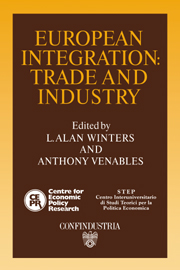Book contents
- Frontmatter
- Contents
- List of figures
- List of tables
- Preface
- Acknowledgements
- List of conference participants
- 1 European integration: trade and industry
- 2 Completing the internal market in the EC: factor demands and comparative advantage
- Discussion
- 3 External effects and Europe's integration
- Discussion
- 4 The quality and production of textiles and clothing and the completion of the internal market
- Discussion
- 5 Competition and imports in the European market
- Discussion
- 6 The structure and determinants of East–West trade: a preliminary analysis of the manufacturing sector
- Discussion
- 7 1992 and EFTA
- Discussion
- 8 Technology policy in the completed European market
- Discussion
- 9 Corporation tax, foreign direct investment and the single market
- Discussion
- 10 Japanese direct manufacturing investment in Europe
- Discussion
- Index
Discussion
Published online by Cambridge University Press: 07 September 2010
- Frontmatter
- Contents
- List of figures
- List of tables
- Preface
- Acknowledgements
- List of conference participants
- 1 European integration: trade and industry
- 2 Completing the internal market in the EC: factor demands and comparative advantage
- Discussion
- 3 External effects and Europe's integration
- Discussion
- 4 The quality and production of textiles and clothing and the completion of the internal market
- Discussion
- 5 Competition and imports in the European market
- Discussion
- 6 The structure and determinants of East–West trade: a preliminary analysis of the manufacturing sector
- Discussion
- 7 1992 and EFTA
- Discussion
- 8 Technology policy in the completed European market
- Discussion
- 9 Corporation tax, foreign direct investment and the single market
- Discussion
- 10 Japanese direct manufacturing investment in Europe
- Discussion
- Index
Summary
This is a very comprehensive study on the forms of corporate taxation that might be adopted by nations, and their consequences for the investment and financial behaviour of multinational enterprises. Of especial interest to me is the analysis of the potential consequences of 1992. This is assumed to take the form of integration of previously segmented national markets, with the result that both the parent and the affiliate of the multinational end up supplying goods to the same market. Such an event has a dramatic outcome. In a segmented market regime, countries have a degree of independence in their choices of statutory tax rates; within an integrated market, differences in these rates are liable to distort investment decisions with the result that ‘production will be entirely concentrated wherever the effective average tax rate is lowest’.
The focus of the study is the multinational firm that has both parent and affiliate located within a customs union (such as the EC). In the absence of a harmonisation of national corporate tax schedules, market integration will thus result in the eventual concentration of production in the location that has the most favourable tax climate for the firm (which might even be a third country within the EC). I am particularly interested in how this result relates to the predictions made from international trade theory as to the effects of market integration.
In the presence of increasing returns to scale in manufacturing, it is clear that it is more efficient for a firm to produce all of its output in a single location.
- Type
- Chapter
- Information
- European IntegrationTrade and Industry, pp. 198 - 199Publisher: Cambridge University PressPrint publication year: 1991



